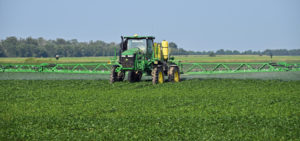Despite control measures the Environmental Protection Agency’ implemented in October 2020, 2021 reports show little change in number, severity or geographic extent of dicamba-related incidents compared to reports the agency received before 2020.
Dicamba use has been subject to considerable controversy, including the 2020 vacatur of the agency’s 2018 dicamba registrations and the 2021 EPA inspector general report on the 2018 dicamba decision. Both noted the agency’s failure to fully disclose and address risks of which it was aware.
EPA received approximately 3,500 dicamba-related incident reports from the 2021 growing season, indicating that:
• More than 1 million acres of non-dicamba-tolerant soybean crops were allegedly damaged by off-target movement of dicamba.
• A range of non-target agricultural crops were allegedly affected by dicamba, such as sugarbeets, rice, sweet potatoes, peanuts and grapes.
• Dicamba allegedly damaged non-agricultural plants and trees, such as those that grow near homes and in wild areas, including a 160,000-acre wildlife refuge.
• More than 280 incident reports came from counties where additional restrictions are required to protect endangered species when dicamba is applied to dicamba-tolerant soybean and cotton crops.
Significantly understated damage
Based on prior research and numerous stakeholder meetings, EPA has reason to believe the number of incidents reported significantly understates the actual number of incidents related to dicamba use. For example, in a 2020 memo, EPA estimated that one in 25 dicamba incidents was reported to the agency. No evidence available to EPA suggests that underreporting has changed.
Given the new information from the 2021 growing season, EPA is reviewing whether over-the-top dicamba can be used in a manner that does not pose unreasonable risks to non-target crops and other plants or to listed species and their designated critical habitats. The agency is also evaluating its options for addressing future dicamba-related incidents.
The regulatory tools the agency could use to address the extent and severity of the alleged dicamba-related incidents are unlikely to be fully implemented by the 2022 growing season due to required statutory processes.
State requirements
However, EPA is committed to helping states address issues related to incidents in their jurisdictions. If a state wishes to further restrict or narrow the over-the-top uses of dicamba, the agency will work with them to support their goals.
Additionally, due to the extent and severity of reported incidents from the 2021 growing season, EPA is unlikely to approve section 24(c) requests under the Federal Insecticide, Fungicide and Rodenticide Act (FIFRA) to register additional uses of federally registered over-the-top dicamba products to meet special local needs.
EPA’s decisions will continue to be based on nformation submitted by, as well as discussions with, scientists, academics, state agriculture Extension agents, pesticide registrants, growers, the U.S. Department of Agriculture, the Association of American Pesticide Control Officials and the State FIFRA Research and Evaluation Group.
To view the report and supporting documents, visit docket EPA-HQ-OPP-2020-0492 at www.regulations.gov.
The Weed Science Society of America contributed this report.
The post EPA summary of 2021 dicamba-related incidents shows little change appeared first on Soybean South.
Despite control measures the Environmental Protection Agency’ implemented in October 2020, 2021 reports show little change in number, severity or geographic extent of dicamba-related incidents compared to reports the agency received before 2020.
Dicamba use has been subject to considerable controversy, including the 2020 vacatur of the agency’s 2018 dicamba registrations and the 2021 EPA inspector general report on the 2018 dicamba decision. Both noted the agency’s failure to fully disclose and address risks of which it was aware.
EPA received approximately 3,500 dicamba-related incident reports from the 2021 growing season, indicating that:
• More than 1 million acres of non-dicamba-tolerant soybean crops were allegedly damaged by off-target movement of dicamba.
• A range of non-target agricultural crops were allegedly affected by dicamba, such as sugarbeets, rice, sweet potatoes, peanuts and grapes.
• Dicamba allegedly damaged non-agricultural plants and trees, such as those that grow near homes and in wild areas, including a 160,000-acre wildlife refuge.
• More than 280 incident reports came from counties where additional restrictions are required to protect endangered species when dicamba is applied to dicamba-tolerant soybean and cotton crops.
Significantly understated damage
Based on prior research and numerous stakeholder meetings, EPA has reason to believe the number of incidents reported significantly understates the actual number of incidents related to dicamba use. For example, in a 2020 memo, EPA estimated that one in 25 dicamba incidents was reported to the agency. No evidence available to EPA suggests that underreporting has changed.
Given the new information from the 2021 growing season, EPA is reviewing whether over-the-top dicamba can be used in a manner that does not pose unreasonable risks to non-target crops and other plants or to listed species and their designated critical habitats. The agency is also evaluating its options for addressing future dicamba-related incidents.
The regulatory tools the agency could use to address the extent and severity of the alleged dicamba-related incidents are unlikely to be fully implemented by the 2022 growing season due to required statutory processes.
State requirements
However, EPA is committed to helping states address issues related to incidents in their jurisdictions. If a state wishes to further restrict or narrow the over-the-top uses of dicamba, the agency will work with them to support their goals.
Additionally, due to the extent and severity of reported incidents from the 2021 growing season, EPA is unlikely to approve section 24(c) requests under the Federal Insecticide, Fungicide and Rodenticide Act (FIFRA) to register additional uses of federally registered over-the-top dicamba products to meet special local needs.
EPA’s decisions will continue to be based on nformation submitted by, as well as discussions with, scientists, academics, state agriculture Extension agents, pesticide registrants, growers, the U.S. Department of Agriculture, the Association of American Pesticide Control Officials and the State FIFRA Research and Evaluation Group.
To view the report and supporting documents, visit docket EPA-HQ-OPP-2020-0492 at www.regulations.gov.
The Weed Science Society of America contributed this report.





